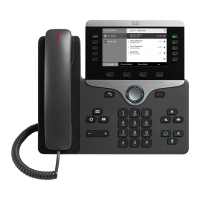7
Request the CTL file. The TFTP server stores the CTL file. This file contains the certificates that are
necessary for establishing a secure connection between the phone and Cisco Unified Communications
Manager.
For more information, the documentation for your particular Cisco Unified Communications Manager
release.
8
Request the ITL file. The phone requests the ITL file after it requests the CTL file. The ITL file contains
the certificates of the entities that the phone can trust. The certificates are used to authenticate a secure
connection with the servers or to authenticate a digital signature signed by the servers. Cisco Unified
Communications Manager 8.5 and later supports the ITL file.
9
Access a TFTP server. In addition to assigning an IP address, the DHCP server directs the Cisco IP Phone
to a TFTP Server. If the phone has a statically defined IP address, you must configure the TFTP server
locally on the phone; the phone then contacts the TFTP server directly.
You can also assign an alternate TFTP server to use instead of the one that DHCP assigns.Note
10
Request the configuration file. The TFTP server has configuration files, which define parameters for
connecting to Cisco Unified Communications Manager and other information for the phone.
11
Contact Cisco Unified Communications Manager. The configuration file defines how the Cisco IP Phone
communicates with Cisco Unified Communications Manager and provides a phone with the load ID. After
it obtains the file from the TFTP server, the phone attempts to make a connection to the highest priority
Cisco Unified Communications Manager on the list.
If the security profile of the phone is configured for secure signaling (encrypted or authenticated) and the
Cisco Unified Communications Manager is set to secure mode, the phone makes a TLS connection.
Otherwise, the phone makes a nonsecure TCP connection.
If the phone was manually added to the database, Cisco Unified Communications Manager identifies the
phone. If the phone was not manually added to the database and autoregistration is enabled in Cisco Unified
Communications Manager, the phone attempts to autoregister itself in the Cisco Unified Communications
Manager database.
Autoregistration is disabled when you configure the CTL client. In this case, you must add the phone to
the Cisco Unified Communications Manager database manually.
Note
Related Topics
Cisco Unified Communications Manager Documentation, on page xvii
External Devices
We recommend that you use good-quality external devices that are shielded against unwanted radio frequency
(RF) and audio frequency (AF) signals. External devices include headsets, cables, and connectors.
Depending on the quality of these devices and their proximity to other devices, such as mobile phones or
two-way radios, some audio noise may still occur. In these cases, we recommend that you take one or more
of these actions:
Cisco IP Phone 8800 Series Administration Guide for Cisco Unified Communications Manager
20
External Devices

